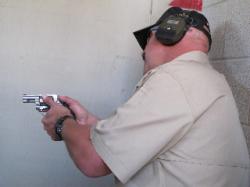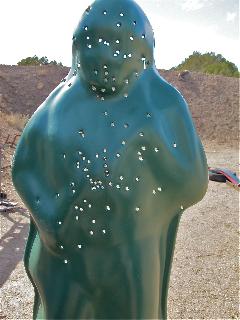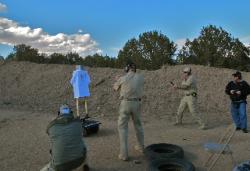Widgetized Section
Go to Admin » Appearance » Widgets » and move Gabfire Widget: Social into that MastheadOverlay zone
Dance the Robot, Don’t Fight It
Wrapping up our training event at Gunsite -and blending in some video shooting for the second season of Guns & Gear on VERSUS- I received a vivid demonstration as to why some trainers and friends tell me that when it comes to backup guns “one is none, and two is one”.
It’s not just belt and suspenders logic, or even healthy paranoia. It is recognition of the fact that with small guns in times of duress, it is easy to miss with a couple of shots and/or run out of ammo before the fight is ended.
Neither of these is a good option when training. When you’re in a life-or-death situation, either could prove fatal.
I had the empirical demonstration administered this week during my Gunsite “mouse gun and pocket light” training. Fortunately, my pride was all that was damaged, but it suffered some pretty serious wounds.
It started simply enough. We worked with pocket pistols and revolvers until we were confident of our abilities to hit targets at 5-7 yards. Then, we transitioned to pocket guns and flashlights, practicing the four most common light/gun techniques (Rogers/SureFire, Neck Index, Harries, and Modified FBI). That practice was done at night, on Gunsite’s outdoor range.

At that point, we moved to a pair of shooting houses for room-clearing exercises. They’re not all-that realistic, but more than adequate to get your blood pounding. Under the close supervision of an instructor, you move through a shoot house, practicing your moving and shooting techniques so as to maximize your cover, minimize your exposure and enhance your chances of handling the various bad guys should you ever find yourself in such a situation. Having been in such a situation, the shoot house is more than adequate at conjuring up old memories and sending the heart racing.
These practice sessions were in low light and darkness, making it possible to see how you’d handle these emergencies with- and without – flashlights. They were also run with no reloads- you had either 10, 12 or 14 rounds of ammo in a pair of guns. There were no reloads allowed.
As a personal aside, that was where I ran into trouble. Being of the “when in doubt, keep shooting” mentality, I found myself at the end of one exercise with a room left to clear and no ammo. Embarrassing in training; potentially fatal in real life.
Some of the guys carried three guns- not a bad idea when you’re working such a scenario, but few homeowners are likely to be carrying two-or three guns. It’s also safe to presume that after a little training, everyone would keep a gun and extra ammo together for an emergency.
At the point we started carping about that, instructors Bill Murphy and Giles Stock introduced two acquaintances of theirs into the equation. At that point, we began to realize that having reloads and bringing them into the fight were two distinctly different things.
Their friends? Robots.

Looks ventilated now, but it took lots of those hits outside the critical hit zones to get the green monster to fall down and play disabled.
One was a prototype reaction target- designed to react to fatal hits and take itself out of the fight. It talked (“don’t taze me, man” was my favorite), made threatening noises and had a couple of really nasty death rattles when hit fatally. Unfortunately, those rattles weren’t quite as easy to play as you’d imagine.
The other, well, it was like something out of “Thunderdome” – about 200 pounds of radio controlled aggression. The operator made it move forward, backwards, sideways and blast at you with ridiculous speed and the reckless abandon of a bezerker.
Both did a good job of making some points very obvious about little guns.
They’re far harder-hitting than they’ve ever been, but they require either a ridiculously low-percentage precision shot or a volume of hits to stop a fight.
They carry fewer rounds (far fewer rounds) than modern duty pistols and are slooow to reload. Even with extra magazines, the Ruger LCPs were not as fast to reload and get back into the fight as larger guns. With speed strips, speed loaders or single rounds, the Ruger LCRs and Smith & Wesson snubbies were even slower.
In other words, these were not guns to take to a gunfight – at least not intentionally.
With the mobile robot, we quickly discovered that it was capable of racing around and forcing us to give ground while banging away – even with head shots. Granted, this robot didn’t have the hit sensors of the other unit, but it had the speed and aggression of a determined attacker.
An eye-opening lesson.

3-on-1, Markle, Murphy and Biggers take on the mobile robot. Lots of rounds, plenty of movement, and the robot's still standing.
Instructor Murphy, host Dave Biggers from X-S Sights and law enforcement officer/writer Paul Markle took the robot on in a 3-on-1 exercise. The robot raced around and gave a pretty good demonstration of how even teamwork and fancy footwork doesn’t always beat out a crazed attacker.
In the end, we were all better trained than before, and I took home one lesson that was repeated, well, repeatedly: there’s nothing wrong with NOT getting into a gunfight.
In fact, the gunfight you don’t attend is the best kind you can have.
Trouble isn’t something you go looking for- it’s something you train to either avoid or avert.
Fight as a last resort, but fight to win.
–Jim Shepherd
www.shootingwire.com



 MidwayUSA
MidwayUSA Ruger Firearms
Ruger Firearms SCCY Firearms
SCCY Firearms Streamlight
Streamlight Action Targets
Action Targets Gunsite Academy
Gunsite Academy
You must be logged in to post a comment Login